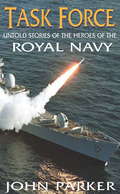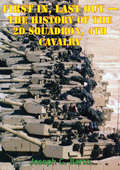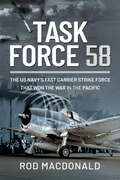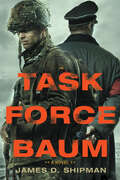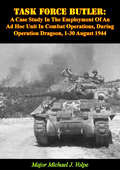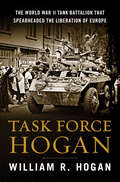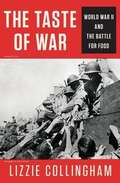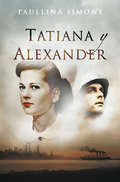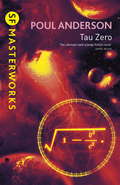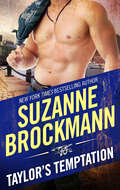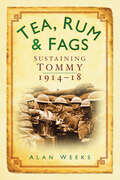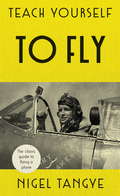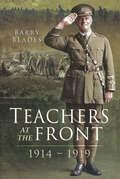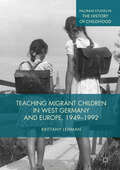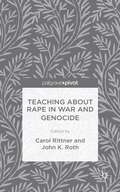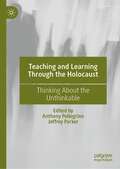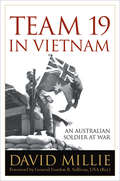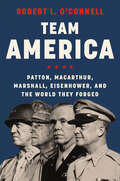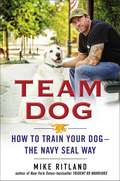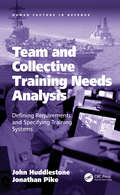- Table View
- List View
Task Force
by John ParkerThe Royal Navy at the start of the twenty-first century had undergone the most remarkable transformation. The Fleet is today the smallest since the start of the Napoleonic wars as surface vessels are no longer viable as a principal line of defence. That preserve is now in the hands of Britain's nuclear-armed submarine fleet, well chronicled in THE SILENT SERVICE and the Air Force, as outlined in STRIKE COMMAND. This book will complete the triangle of our essential military might, telling the story of today's sea-going ultra-mobile, rapid reaction, missile- and aircraft-carrying task force. John Parker includes personal interviews from the men and women who have served in the Senior Service to bring his story vividly to life.
Task Force
by John ParkerThe Royal Navy at the start of the twenty-first century had undergone the most remarkable transformation. The Fleet is today the smallest since the start of the Napoleonic wars as surface vessels are no longer viable as a principal line of defence. That preserve is now in the hands of Britain's nuclear-armed submarine fleet, well chronicled in THE SILENT SERVICE and the Air Force, as outlined in STRIKE COMMAND. This book will complete the triangle of our essential military might, telling the story of today's sea-going ultra-mobile, rapid reaction, missile- and aircraft-carrying task force. John Parker includes personal interviews from the men and women who have served in the Senior Service to bring his story vividly to life.
Task Force 2-4 Cav - First In, Last Out - The History Of The 2d Squadron, 4th Cavalry [Illustrated Edition]
by Major Joseph C. Barto[Includes 5 tables, 10 maps and 20 photos]Wars have been studied from every viewpoint from the most abstract to the intensely personal. In the case of Major Joseph C. Barto's Task Force 2-4 Cav-"First In, Last Out": The History of the 2d Squadron, 4th Cavalry Regiment, During Operation Desert Storm, war is viewed from the perspective of one man's impression of a volatile, fluid battle.Re-creating his experiences in Operation Desert Storm from pieced together notes, an extensive journal, and a variety of other sources, Barto tells the story of TF 2-4 Cav. From his position as the squadron's executive officer and officer in charge of its tactical operations center, Barto reports the planning and execution of his squadron as it advanced across the desert in pursuit of Iraqis.The end result of Barto's reporting is a uniquely personal view of one man's experience during a rapidly evolving operation. Barto's exercise is not meant to be a polished analysis but rather provides students of military history with an inside view of the operations of a cavalry squadron on a dynamic, oftentimes uncertain, battlefield.
Task Force 58: The US Navy's Fast Carrier Strike Force that Won the War in the Pacific
by Rod MacdonaldThe new breed of American fast aircraft carriers could make thirty-three knots, and each carried almost 100 strike aircraft. Brought together as Task Force 58, also known as the Fast Carrier Task Force, this awesome armada at times comprised more than 100 ships carrying more than 100,000 men afloat. By 1945, more than 1,000-combat aircraft, fighters, dive- and torpedo-bombers could be launched in under an hour. The fast carriers were a revolution in naval warfare – it was a time when naval power moved away from the big guns of the battleship to air power projected at sea. Battleships were eventually subordinated to supporting and protecting the fast carriers, of which, at its peak, Task Force 58 had a total of seventeen. This book covers the birth of naval aviation, the appearance of the first modern carriers in the 1920s, through to the famous surprise six-carrier _Kido Butai_ Japanese raid against Pearl Harbor on 8 December 1941 and then the early US successes of 1942 at the Battles of the Coral Sea and Midway. The fast carriers allowed America, in late 1942 and early 1943, to finally move from bitter defence against the Japanese expansionist onslaught, to mounting her own offensive to retake the Pacific. Task Force 58 swept west and north from the Solomon Islands to the Gilbert and Marshall Islands, neutralising Truk in Micronesia, and Palau in the Caroline islands, before the vital Mariana Islands operations, the Battle of Saipan, the first battle of the Philippine Sea and the Great Marianas Turkey Shoot. The strikes by Task Force 58 took Allied forces across the Pacific, to the controversial Battle of Leyte Gulf and to Iwo Jima and Okinawa. Task Force 58 had opened the door to the Japanese home islands themselves – allowing US bombers to finally get close enough to launch the devastating nuclear bombing raids on Hiroshima and Nagasaki. Task Force 58 participated in virtually all the US Navy’s major battles in the Pacific theatre during the last two years of the war. Having spent many years investigating naval shipwrecks across the Pacific, many the result of the devastating effectiveness of Task Force 58, diver and shipwreck author Rod Macdonald has created the most detailed account to date of the fast carrier strike force, the force that brought Japan to its knees and brought the Second World War to its crashing conclusion.
Task Force Baum
by James D. ShipmanIn the tradition of Saving Private Ryan and Bridge Over the River Kwai, bestselling author James D. Shipman delivers a powerful, action-packed novel that illustrates the long-buried secrets and unending costs of war—based on the true story of General Patton’s clandestine unauthorized raid on a World War II POW camp. March, 1945. Allied forces are battle-worn but wearily optimistic. Russia’s Red Army is advancing hard on Germany from the east, bolstering Allied troops moving in from the west and north. Soon, surely, Axis forces must accept defeat. Yet for Captain Jim Curtis, each day is a reminder of how unpredictable and uncertain warfare can be. Captured during the Battle of the Bulge after the Germans launched a devastating surprise attack, Curtis is imprisoned at a POW camp in Hammelburg, Bavaria. Conditions are grim. Inmates and guards alike are freezing and starving, with rations dwindling day by day. But whispers say General Patton’s troops are on the way, and the camp may soon be liberated. Indeed, fifty miles away, a task force of three hundred men is preparing to cross into Germany. With camps up and down the line, what makes Hammelburg so special they don’t know, but orders are orders. Yet their hopes of evading the enemy quickly evaporate. Wracked by poor judgment, insufficient arms, and bad luck, the raid unravels with shattering losses. The liberation inmates hoped for becomes a struggle for survival marked by a stark choice: stay, or risk escaping into danger—while leaving some behind. For Curtis, the decision is an even more personal test of loyalty, friendship, and the values for which one will die or kill. It will be another twenty years before the unsanctioned mission’s secret motivation becomes public knowledge, creating a controversy that will forever color Patton’s legacy and linger on in the lives of those who made it home at last—and the loved ones of those who did not.
Task Force Blue (Rogue Warrior #4)
by Richard Marcinko John Weisman"Moving slowly, steadily across the tarmac through the driving Florida rain, the Rogue Warrior and his team of SEALs have been called into action. Mission: storm a hijacked 727 sitting on a Key West airstrip and rescue the Secretary of the Navy. In a flash of high-tech explosives and automatic gunfire, a hostage is killed - and Marcinko will be the one to pay. Facing a court martial and permanent removal from the Navy, the Rogue Warrior has one more call to answer, from an ultrasecret operative inside the Defense Intelligence Agency (DIA). " "America's worst nightmare has become a reality. The hijackers' roots run deep in U. S. soil: Americans willing to kill Americans to create a government in their own fanatical image. The Pentagon's security has been breached: the arsenal of democracy raided. The DIA needs someone to eradicate the terrorist infrastructure, circumventing the Navy and the FBI. They need Marcinko and his elite SEAL contingent, Task Force Blue. " "Inspired and funded by a politically motivated independent billionaire, the enemy has become a force of right-wing militias and extremists, radical drug gangs, and fundamentalist terrorists - but they have yet to face an adversary like the Rogue Warrior. Accused of murder and pursued by the FBI, operating underground to maneuver through a political, military, and bureaucratic minefield, the Rogue Warrior is right where he wants to be. And, faithful to his ultimate Commandment of SpecWar, there are no rules - Marcinko will win at all costs. "--BOOK JACKET. Title Summary field provided by Blackwell North America, Inc. All Rights Reserved
Task Force Blue (Rogue Warrior #4)
by Richard MarcinkoRichard Marcinko's #1 New York Times bestselling autobiography, Rogue Warrior, brought SpecWar combat out in the open. But only fiction could tell the whole, unrestricted tale in two more explosive New York Times bestsellers—Rogue Warrior: Red Cell and Rogue Warrior: Green Team. Now the Rogue Warrior's back in a raw, authentic novel of relentless action and suspense.When the Rogue Warrior and his elite SEAL team, Task Force Blue, storm a hijacked 727 in Key West, a hostage is killed—and Marcinko must pay. Facing court-martial and removal from the Navy, his is recuited by the Defense Intelligence Agency to erradicate a secret right-wing terrorist infrastructure. Combating a brutal enemy force, and pursued by the FBI, Marcinko maneuvers through a political, military, and bureaucratic minefield, adhering to the ultimate Commandment of SpecWar -- there are no rules -- win at all cost!
Task Force Butler: A Case Study In The Employment Of An Ad Hoc Unit In Combat Operations, During Operation Dragoon, 1-30 August 1944
by Major Michael J. VolpeOn 15 August 1944, an Allied army launched a second amphibious landing against the coast of southern France. The Allies, having shattered German defenses around the beachhead, decided to exploit the chaos in the enemy camp. On 17 August 1944, Major General (MG) Lucian K. Truscott Jr., with no mobile organic strike force assigned to his VI Corps, ordered the assembly of and attack by an ad hoc collection of units roughly equivalent to an armored brigade. This provisional armored group (Task Force (TF) Butler) experienced remarkable success despite a dearth of planning, no rehearsals, and no history of working together in either training or combat. This case study examines the success of TF Butler from the perspectives of doctrinal development in the United States (U.S.) Army, the unit's unique task organization, and the leadership's employment of the unit in combat. The use of ad hoc formations to meet unforeseen situations was not unique to World War II; American units currently serving in the Middle East are regularly assigned units they have no habitual relations with to conduct combat operations. This case study may prove useful in preparing contemporary military leaders for the types of challenges they will face conducting operations in the contemporary operational environment.
Task Force Hogan: The World War II Tank Battalion That Spearheaded the Liberation of Europe
by William R. HoganA fourth-generation soldier tells the story of his father’s tank battalion, the “Spearhead,” that selflessly led the charge on the front lines from Normandy into Germany—against impossible odds, technologically superior weaponry, and a fanatical enemy on its home turf—and the heroes whose sacrifice won World War II.At twenty-eight, Sam Hogan is one of the youngest lieutenant colonels in the US Army. The West Point graduate from Texas stands in the commander’s hatch of his Sherman tank, behind him a steel wedge of seventeen other Shermans of his tank battalion. Two weeks after the now-infamous D-Day landings, Sam is preparing to give the order to advance into the German defenses that enclose the Normandy beachheads. Ahead of Sam lies seemingly impossible odds for survival: technologically superior Nazi tanks, camouflaged anti-tank guns, and infantry armed with new anti-tank rockets. But Sam has prepared for this moment for the past seven years. With a guttural call to move out accompanied by diesel fumes and the squeak of tank treads, Sam and his men begin their long journey to liberate Europe—a journey from which many of them would not return.So begins the story of Sam Hogan and his colorful band of tanker heroes of the Third Armored Division—the “Spearhead”—as they battle on the front lines of some of the war’s toughest fights, from Normandy to the Elbe to the Battle of the Bulge. The soldiers of Task Force Hogan come from all walks of life. There are cooks, tankers, infantrymen, salty old sergeants, and wet-behind-the-ears lieutenants. In common, they have a sense of duty to each other and their country, and the struggle against the most sinister enemy modern history has ever produced.In Task Force Hogan, the story of Sam and his band of heroes comes to life through the writing of his son, Will Hogan—aided by never-before-seen letters, military dispatches, journal entries, and interviews with surviving family of the Task Force. These were the soldiers at the tip of the spear, brave enough to lead the charge and fight against insurmountable odds, and often paying the ultimate price, while liberating French villages and concentration camps as they rolled towards Germany to ultimately win the war. In the pages of this book, Will Hogan finally gives these unsung soldiers the voice and memorial that they all deserve.
Taste of War
by Lizzie CollinghamA New York Times Notable Book of 2012Food, and in particular the lack of it, was central to the experience of World War II. In this richly detailed and engaging history, Lizzie Collingham establishes how control of food and its production is crucial to total war. How were the imperial ambitions of Germany and Japan - ambitions which sowed the seeds of war - informed by a desire for self-sufficiency in food production? How was the outcome of the war affected by the decisions that the Allies and the Axis took over how to feed their troops? And how did the distinctive ideologies of the different combatant countries determine their attitudes towards those they had to feed?Tracing the interaction between food and strategy, on both the military and home fronts, this gripping, original account demonstrates how the issue of access to food was a driving force within Nazi policy and contributed to the decision to murder hundreds of thousands of 'useless eaters' in Europe. Focusing on both the winners and losers in the battle for food, The Taste of War brings to light the striking fact that war-related hunger and famine was not only caused by Nazi Germany and Imperial Japan, but was also the result of Allied mismanagement and neglect, particularly in India, Africa and China.American dominance both during and after the war was not only a result of the United States' immense industrial production but also of its abundance of food. This book traces the establishment of a global pattern of food production and distribution and shows how the war subsequently promoted the pervasive influence of American food habits and tastes in the post-war world. A work of great scope, The Taste of War connects the broad sweep of history to its intimate impact upon the lives of individuals.
Tatiana y Alexander (El jinete de bronce #Volumen 2)
by Paullina SimonsLa conmovedora segunda parte de la trilogía «El jinete de bronce». Embarazada, enferma y absolutamente desolada, Tatiana ha logrado llegar a Estados Unidos. Entregada a la fuerza de las circunstancias y alejada de su convulsionada tierra, la joven comenzará una nueva existencia con la secreta ilusión de que, en alguna parte, el hombre al que ama sea capaz de vencer a las oscuras garras del destino. Mientras, Alexander sufre el hostigamiento de las fuerzas represoras en las gélidas tierras de la Unión Soviética, y tan solo el recuerdo de su esposa, junto con la velada esperanza de que siga con vida, alimenta su espíritu ante la adversidad. Al tiempo que la contienda llega a su final, ambos lucharán contra sus destinos y la desesperación en busca del amor perdido y la inquebrantable esperanza del reencuentro. La crítica ha dicho...«Una historia de amor que te dejará sin aliento.»Daily Mail «Bellamente escrita. Difícil de dejar. Altamente recomendable.»Library Journal
Tau Zero (S.F. MASTERWORKS)
by Poul AndersonThe epic voyage of the spacecraft Leonora Christine will take her and her fifty-strong crew to a planet some thirty light-years distant. But, because the ship will accelerate to close to the speed of light, for those on board subjective time will slow and the journey will be of only a few years' duration.Then a buffeting by an interstellar dustcloud changes everything. The ship's deceleration system is damaged irreperably and soon she is gaining velocity. When she attains light-speed, tau zero itself, the disparity between ship-time and external time becomes almost impossibly great. Eons and galaxies hurtle by, and the crew of the Leonora Christine speeds into the unknown.
Taylor's Temptation (Tall, Dark and Dangerous #10)
by Suzanne BrockmannA Navy SEAL struggles to resist his attraction to his best friend’s younger sister in this romantic suspense from a New York Times–bestselling author .Protecting the innocent is Navy SEAL Bobby Taylor’s passion. That’s why his best friend asked him to look out for his little sister, Colleen. Except that Colleen’s all grown up now, which has Bobby wanting to do so much more than keep her safe . . .
Te prometo un imperio
by Juan VilchesUna emocionante intriga en torno al viaje de Eduardo VIII y Wallis Simpson al Madrid de la Segunda Guerra Mundial. Mientras las tropas nazis avanzan imparables por toda Europa, el recién destronado rey Eduardo VIII y su mujer, la americana Wallis Simpson, plebeya y divorciada, huyen de Francia y recalan en el hotel Ritz, de Madrid. El viaje de Eduardo pone en jaque a las altas instancias políticas y diplomáticas inglesas, alemanas y españolas, que temen que esté tramando alguna acción contra su hermano Jorge VI, el rey tartamudo. Para complicar aún más el delicado equilibrio diplomático, el ayudante de campo de Eduardo aparece asesinado en la habitación contigua a la de los duques de Windsor. Mientras Franco y sus ministros intentan aprovechar esta crisis para beneficiar sus intereses en Europa, el capitán del ejército Arturo Sotomayor y el comisario de la policía Fontecha deberán superar sus diferencias y resolver un caso lleno de obstáculos. Pero ninguno de los dos cuenta con la fiera determinación de Wallis para proteger a su marido y luchar por el trono de Inglaterra, ni con una misteriosa mujer extranjera cercana al círculo de los duques, que sabe más de lo que aparenta... Una apasionante novela en torno a Wallis Simpson, una de las mujeres más fascinantes del siglo XX conocida por el éxito cinematográfico de El discurso del rey, que mezcla suspense y romance, ficción y realidad de forma insuperable.
Tea, Rum and Fags: Sustaining Tommy 1914-1918
by Alan WeeksIt is said that 'an army marches on its stomach', but histories of the First World War usually concentrate on its political and military aspects. The gargantuan task of keeping the British Expeditionary Force fed and watered is often overlooked, yet without adequate provision the soldiers would never have been able to fight. Tommy couldn't get enough tea, rum or fags, yet his commanders sent him bully beef and dog biscuits. But it was amazing how 2 million men did not usually go short of nourishment, although parcels from home, canteens and estaminets had a lot to do with that. Incredibly, Tommy could be in a civilised town supping beer, wine, egg and chps, and a few hours later making do with bully beef in a water-filled trench. Alan Weeks examines how the army got its food and drink and what it was like.
Teach Yourself to Fly: The classic guide to flying a plane
by Nigel TangyeFirst published in 1938, Teach Yourself To Fly was not only one of the very first Teach Yourself books to be published but the first to actually change the world. It was used on the eve of the second world war to prepare pilot recruits and conscripts before they were called for service, and as such it was read religiously by thousands of young men, some as young as 17, and directly impacted on the British war effort.This beautiful new printing of the book captures all of the feelings of that extraordinary time - it's nostalgic, understated, inspiring and very British indeed, warning young pilots, amongst other things, not to feel 'too discouraged' in the event of a crash landing.Technology has changed hugely, but the principles of aviation as they were in the middle of the twentieth century are perfectly summarised in this lovely book. Get hold of the right vehicle, and it really can teach you to fly. What happens when you're up there, however, is your responsibility.Since 1938, millions of people have learned to do the things they love with Teach Yourself. Welcome to the how-to guides that changed the modern world.
Teach Yourself to Fly: The classic guide to flying a plane
by Nigel TangyeFirst published in 1938, Teach Yourself To Fly was not only one of the very first Teach Yourself books to be published but the first to actually change the world. It was used on the eve of the second world war to prepare pilot recruits and conscripts before they were called for service, and as such it was read religiously by thousands of young men, some as young as 17, and directly impacted on the British war effort.This beautiful new printing of the book captures all of the feelings of that extraordinary time - it's nostalgic, understated, inspiring and very British indeed, warning young pilots, amongst other things, not to feel 'too discouraged' in the event of a crash landing.Technology has changed hugely, but the principles of aviation as they were in the middle of the twentieth century are perfectly summarised in this lovely book. Get hold of the right vehicle, and it really can teach you to fly. What happens when you're up there, however, is your responsibility.Since 1938, millions of people have learned to do the things they love with Teach Yourself. Welcome to the how-to guides that changed the modern world.
Teachers at the Front, 1914–1919
by Barry BladesAugust 1914. Flags waved, people cheered and armies mobilized. Millions of citizens throughout Britain responded to the call-to-arms. War fever was contagious. In the far reaches of empire, young men also pledged their allegiance and prepared to serve the King and his empire. Amongst the patriots who joined the colors were thousands of schoolmasters and trainee teachers. In London, students and alumni from the London Day Training College left their classrooms and took the King’s Shilling. In the dominions, hundreds of their professional counterparts in Perth, Auckland and Toronto similarly reported to the military training grounds, donned khaki uniforms and then embarked for the ‘old county’ in its hour of need. Teachers at the Front 1914-1919 tells the story of these men. It recalls the decisions made by men who were united by their training, occupation and imperial connections, but were divided by social and geographical contexts, personal beliefs and considered actions. It follows these teacher-soldiers as they landed on the beaches of Gallipoli, attacked across no man's land in Flanders, on the Somme and at Passchendaele, and finally broke through the Hindenburg Line and secured victory. Many did not survive the carnage of what became known as the Great War. For those who did, wartime officers and men who had been proud to call themselves Tommies, Anzacs, Enzeds and Canucks, returning home presented further challenges and adjustments.
Teaching Migrant Children in West Germany and Europe, 1949–1992 (Palgrave Studies in the History of Childhood)
by Brittany LehmanThis book examines the right to education for migrant children in Europe between 1949 and 1992. Using West Germany as a case study to explore European trends, the book analyzes how the Council of Europe and European Community’s ideological goals were implemented for specific national groups. The book starts with education for displaced persons and exiles in the 1950s, then compares schooling for Italian, Greek, and Turkish labor migrants, then circles back to asylum seekers and returning ethnic Germans. For each group, the state entries involved tried to balance equal education opportunities with the right to personhood, an effort which became particularly convoluted due to implicit biases. When the European Union was founded in 1993, children’s access to education depended on a complicated mix of legal status and perception of cultural compatibility. Despite claims that all children should have equal opportunities, children’s access was limited by citizenship and ethnic identity.
Teaching about Rape in War and Genocide
by John K. Roth Carol RittnerTeaching about Rape in War and Genocide.
Teaching and Learning Through the Holocaust: Thinking About the Unthinkable
by Jeffrey Parker Anthony PellegrinoThis book serves as a critical resource for educators across various roles and contexts who are interested in Holocaust education that is both historically sound and practically relevant. As a collection, it pulls together a diverse group of scholars to share their research and experiences. The volume endeavors to address topics including the nature and purpose of Holocaust education, how our understanding of the Holocaust has changed, and resources we can use with learners. These themes are consistent across the chapters, making for a comprehensive exploration of learning through the Holocaust today and in the future.
Team 19 in Vietnam: An Australian Soldier at War (Foreign Military Studies)
by David MillieAn Australian Army veteran offers a rare glimpse into the multi-national operations of the Vietnam War in this vivid and thoroughly researched memoir.In Team 19 in Vietnam, David Millie offers an insightful account of his twelve-month tour with the renowned Australian Army Training Team Vietnam in Quang Tri Province—a crucial tactical site along the demilitarized zone that was North Vietnam's gateway to the south. This firsthand narrative vividly demonstrates the importance of the region and the substantial number of forces engaged there.Drawing from published and unpublished military documents, his personal diary, and the letters he wrote while deployed, Millie introduces readers to the daily routines, actions, and disappointments of a field staff officer. Millie also discusses his interactions with province senior advisor Colonel Harley F. Mooney and Major John Shalikashvili, who would later become chairman of the US Joint Chiefs of Staff.Few Australian accounts of the Vietnam War exist, and Millie offers a fresh perspective on the year after the Tet offensive. He contends that responsibility for the catastrophe inflicted on Vietnamese civilians is shared by an international community that failed to act effectively in the face of a crisis.
Team America: Patton, MacArthur, Marshall, Eisenhower, and the World They Forged
by Robert L. O'ConnellFrom national bestselling author and acclaimed military historian Robert L. O’Connell, a dynamic history of four military leaders whose extraordinary leadership and strategy led the United States to success during World War I and beyond.By the first half of the twentieth century, technology had transformed warfare into a series of intense bloodbaths in which the line between soldiers and civilians was obliterated, resulting in the deaths of one hundred million people. During this period, four men exhibited unparalleled military leadership that led the United States victoriously through two World Wars: Douglas MacArthur, George Patton, George Marshall, and Dwight “Ike” Eisenhower; or, as bestselling author Robert O’Connell calls them, Team America.O’Connell captures these men’s unique charisma as he chronicles the path each forged—from their upbringings to their educational experiences to their storied military careers—experiences that shaped them into majestic leaders who would play major roles in saving the free world and preserving the security of the United States in times of unparalleled danger. O’Connell shows how the lives of these men—all born within the span of a decade—twisted around each other like a giant braid in time. Throughout their careers, they would use each other brilliantly in a series of symbiotic relationships that would hold increasingly greater consequences.At the end of their star-studded careers (twenty-four out of a possible twenty-five), O’Connell concludes that what set Team America apart was not their ability to wield the proverbial sword, but rather their ability to plot strategy, give orders, and inspire others. The key ingredients to their success was mental agility, a gravitas that masked their intensity, and an almost intuitive understanding of how armies in the millions actually functioned and fought. Without the leadership of these men, O’Connell makes clear, the world we know would be vastly different.
Team Dog: How to Train Your Dog--the Navy SEAL Way
by Gary Brozek Mike RitlandNew York Times-bestselling author and former Navy SEAL Mike Ritland teaches all dog owners how to have the close relationship and exceptional training of combat dogs. <P><P>In TEAM DOG, Mike taps into fifteen years' worth of experience and shares, explaining in accessible and direct language, the science behind the importance of gaining a dog's trust and then offering invaluable steps for how to achieve any level of obedience. His unique approach uses entertaining examples and anecdotes from his work with dogs on and off the battlefield and direct tips from the Navy SEAL guidebook to teach dog owners how to: choose the perfect dog for their household, establish themselves as the "team leader," master "command and control," employ "situational awareness," and to solidify their dog's position as the family's ultimate best friend.<P>TEAM DOG introduces pet owners everywhere to the new and distinctive authority on how to train your dog. . . the SEAL way.
Team and Collective Training Needs Analysis: Defining Requirements and Specifying Training Systems (Human Factors in Defence)
by Jonathan Pike John HuddlestoneMilitary capability is delivered operationally at a team and collective level, be it a unit as small as a squad or section, or as large as a maritime task group. Modern military forces are required to deal with a potentially wide range of missions frequently involving multiple alliance partners, within a geopolitical environment which can seem to change rapidly. Individual performance, while being important, is not the primary determinant of mission success - force integration, interoperability, adaptability and teamwork are key factors. Team and collective training which fully addresses these factors is fundamental to the development and delivery of military capability. As a consequence, the requirement to determine training requirements and specify effective systems for the delivery of team and collective training is critical to operational success. Training Needs Analysis (also known as Front End Analysis), is a well-established methodology for analysing training requirements and specifying training solutions used extensively by the UK and its NATO partners. However, the analytical techniques employed are optimised for individual training, with little guidance being offered on its application in the team and collective context. Team and Collective Training Needs Analysis (TCTNA) has been developed to close this methodological gap. It addresses the issues of the relationship of individual and team tasks, teamwork, command and control, task and training environments, scenario definition, instructional strategy, team training approaches, instructional functions, and wide-ranging organisational and procurement considerations. Part One of the book develops an integrated set of models which underpin the analytical approach presented in Part Two. Worked examples and case studies illustrate the application of the approach. Between 2005 and 2015 the authors worked on numerous training-related research projects at Cranfield University and Coventry University for the Human Factors Integration Defence Technology Centre and the Defence Human Capability Science and Technology Centre on behalf of the Defence Science and Technology Laboratory, UK Ministry of Defence.
